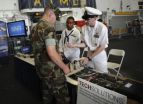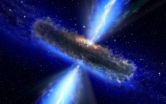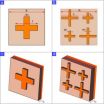(Press-News.org) NEW YORK (July 22, 2011)—A genetic study of the world's largest sheep species has revealed that the big-horned animals travel extensively across the moutainous borders of Afghanistan, Tajikistan, and China according to Wildlife Conservation Society researchers with the support of the U.S. Agency for International Development (USAID).
Using a non-invasive technique that extracts DNA from fecal samples, researchers in WCS's Afghanistan Program found that Marco Polo sheep in the Pamir Mountains of Afghanistan are genetically connected to sheep in neighboring Tajikistan and China, in spite of the challenging terrain.
The study produced two recently published papers, appearing in recent editions of Conservation Genetics and Journal of Wildlife Management. The authors of the papers include: Richard.B. Harris of the University of Montana, and John Winnie, Jr.of Montana State University (both of whom did their work under the auspices of the Wildlife Conservation Society); Gordon Luikart, Stephen. J. Amish, and F.W. Allendorf of the University of Montana; and Albano Beja-Pereira, Vânia Costa, and Raquel Godinho of the Universidade do Porto (Portugal).
"Wide-ranging species such as Marco Polo sheep are difficult to monitor in the best of conditions, and our ability to follow them across their mountain habitats is limited," said Richard B. Harris, a wildlife scientist from the University of Montana and the Wildlife Conservation Society. "Non-invasive methods of determining population trends and relatedness are extremely valuable in understanding how to best protect these magnificent animals."
Because Marco Polo (or argali) sheep are elusive animals that are difficult to track, the research team collected fecal samples from 172 individual sheep from five different areas in Afghanistan, Tajikistan, and China as a means of answering questions about the genetic diversity and connectivity of animals in the region. Researchers searched for sheep on high vantage points, collecting fecal pellets after a group of animals was located. Genetic material was then extracted from the fecal matter and isolated for statistical analysis.
According to the study results, Marco Polo sheep populations in the Pamirs have a high degree of genetic diversity. Indications of genetic connectivity were detected between sheep populations in both Afghanistan and Tajikistan. Sheep in China, however, were found to be somewhat more isolated, highlighting a need for international collaboration in protecting corridors between the region's countries.
"Genetic studies such as these are the only feasible option for answering important questions on how to best manage wide-ranging species that occur in remote locations such as the Marco Polo sheep," said Peter Zahler, Deputy Director for WCS's Asia Program. "The study's results underline the need for international cooperation between Afghanistan, Tajikistan, China, and even Pakistan to ensure that the world's Marco Polo sheep populations can continue to move across these giant mountains as needed, irrespective of political boundaries."
With the assistance of WCS and support from USAID (United States Agency for International Development), the government of Afghanistan has launched several initiatives to safeguard the country's wild places and the wildlife they contain. In 2009, the government gazetted the country's first national park, Band-e-Amir. The park was established with technical assistance from WCS's Afghanistan Program. WCS also worked with Afghanistan's National Environment Protection Agency (NEPA) in producing the country's first-ever list of protected species, an action that now bans the hunting of snow leopards, wolves, brown bears, and other species. In a related effort, WCS now works to limit illegal wildlife trade in the country through educational workshops for soldiers at Bagram Air Base and other military bases across Afghanistan. WCS also works with more than 55 local communities in Afghanistan to better manage their natural resources, helping them conserve wildlife while improving their livelihoods. WCS has helped train and deploy more than 50 community rangers to monitor wildlife such as Marco Polo sheep, and also patrol the region to stop poaching.
The Marco Polo sheep is actually a subspecies of argali and is named after the 13th Century explorer who described the animal in his travelogue. Argali are classified as Near Threatened by the International Union for the Conservation of Nature (IUCN). Marco Polo sheep are threatened by human-related activities such as poaching, habitat degradation and fragmentation.
INFORMATION:
The Wildlife Conservation Society saves wildlife and wild places worldwide. We do so through science, global conservation, education and the management of the world's largest system of urban wildlife parks, led by the flagship Bronx Zoo. Together these activities change attitudes towards nature and help people imagine wildlife and humans living in harmony. WCS is committed to this mission because it is essential to the integrity of life on Earth. Visit www.wcs.org.
World's largest sheep an international traveler
2011-07-25
ELSE PRESS RELEASES FROM THIS DATE:
Fool's gold gives scientists priceless insight into Earth's evolution
2011-07-25
Fool's gold is providing scientists with valuable insights into a turning point in the Earth's evolution, which took place billions of years ago.
Scientists are recreating ancient forms of the mineral pyrite – dubbed fool's gold for its metallic lustre – that reveal details of past geological events.
Detailed analysis of the mineral is giving fresh insight into the Earth before the Great Oxygenation Event, which took place 2.4 billion years ago. This was a time when oxygen released by early forms of bacteria gave rise to new forms of plant and animal life, transforming ...
Office of Naval Research's TechSolutions program lightens burden for Navy's EOD team
2011-07-25
ARLINGTON, Va. — Designed to cut the 50 pounds of battery devices hauled by the Navy's explosive ordnance disposal (EOD) teams, the Office of Naval Research's (ONR) TechSolutions Program has developed a lightweight power system, which was delivered July. 22.
Responding to a request from the Explosive Ordnance Disposal Training and Evaluation Unit (EODTEU) 2 to create a lightweight power device to charge their specialized equipment, TechSolutions partnered with Naval Surface Warfare Center Crane, Ind., and Protonex Technology Corp. to develop the Power Management Kit (PMK) ...
Deepwater Horizon crude less toxic to bird eggs after weathering at sea
2011-07-25
After collecting weathered crude oil from the Gulf of Mexico following the Deepwater Horizon oil spill, researchers at The Institute of Environmental and Human Health (TIEHH) at Texas Tech University have reported that only 8 to 9 percent coverage on the shells of fertilized mallard duck eggs resulted in a 50 percent mortality rate.
However, scientists also reported the amount of time the oil remained at sea and exposed to weather had a significant effect on its toxicity to the fertilized duck eggs, said Phil Smith, an associate professor at TIEHH. They published their ...
Caltech-led astronomers discover the largest and most distant reservoir of water yet
2011-07-25
PASADENA, Calif.—Water really is everywhere. Two teams of astronomers, each led by scientists at the California Institute of Technology (Caltech), have discovered the largest and farthest reservoir of water ever detected in the universe. Looking from a distance of 30 billion trillion miles away into a quasar—one of the brightest and most violent objects in the cosmos—the researchers have found a mass of water vapor that's at least 140 trillion times that of all the water in the world's oceans combined, and 100,000 times more massive than the sun.
Because the quasar is ...
Penn: Nanoplasmonic 'whispering gallery' breaks emission time record in semiconductors
2011-07-25
PHILADELPHIA — Renaissance architects demonstrated their understanding of geometry and physics when they built whispering galleries into their cathedrals. These circular chambers were designed to amplify and direct sound waves so that, when standing in the right spot, a whisper could be heard from across the room. Now, scientists at the University of Pennsylvania have applied the same principle on the nanoscale to drastically reduce emission lifetime, a key property of semiconductors, which can lead to the development of new ultrafast photonic devices.
The research ...
Earliest watery black hole discovered
2011-07-25
Pasadena, CA— Water really is everywhere. A team of astronomers have found the largest and farthest reservoir of water ever detected in the universe—discovered in the central regions of a distant quasar. Quasars contain massive black holes that are steadily consuming a surrounding disk of gas and dust; as it eats, the quasar spews out huge amounts of energy. The energy from this particular quasar was released some 12 billion years ago, only 1.6 billion years after the Big Bang and long before most of the stars in the disk of our Milky Way galaxy began forming.
The research ...
Can feeling too good be bad? Positive emotion in bipolar disorder
2011-07-25
Positive emotions like joy and compassion are good for your mental and physical health, and help foster creativity and friendship. But people with bipolar disorder seem to have too much of a good thing. In a new article to be published in the August issue of Current Directions in Psychological Science, a journal of the Association for Psychological Science, psychologist June Gruber of Yale University considers how positive emotion may become negative in bipolar disorder.
One of the characteristics of bipolar disorder is the extreme periods of positive mood, or mania. ...
Farthest, largest water mass in universe discovered
2011-07-25
An international team of astronomers led by the California Institute of Technology and involving the University of Colorado Boulder has discovered the largest and farthest reservoir of water ever detected in the universe.
The distant quasar is one of the most powerful known objects in the universe and has an energy output of 1,000 trillion suns -- about 65,000 times that of the Milky Way galaxy. The quasar's power comes from matter spiraling into the central supermassive black hole, estimated at some 20 billion times the mass of our sun, said study leader Matt Bradford ...
Shining a light on the elusive 'blackbody' of energy research
2011-07-25
CHESTNUT HILL, MA (July 22, 2011) – A designer metamaterial has shown it can engineer emitted "blackbody" radiation with an efficiency beyond the natural limits imposed by the material's temperature, a team of researchers led by Boston College physicist Willie Padilla report in the current edition of Physical Review Letters.
A "blackbody" object represents a theorized ideal of performance for a material that perfectly absorbs all radiation to strike it and also emits energy based on the material's temperature. According to this blackbody law, the energy absorbed is equal ...
Life scientists use novel technique to produce genetic map for African Americans
2011-07-25
UCLA life scientists and colleagues have produced one of the first high-resolution genetic maps for African American populations. A genetic map reveals the precise locations across the genome where DNA from a person's father and mother have been stitched together through a biological process called "recombination." This process results in new genetic combinations that are then passed on to the person's children.
The new map will help disease geneticists working to map genetic diseases in African Americans because it provides a more accurate understanding of recombination ...




